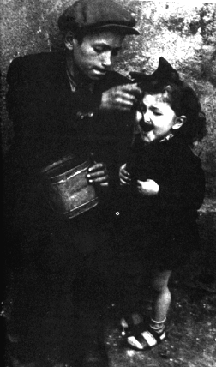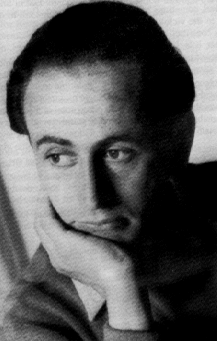 Literature
Literature
 Click here for a Brief Introduction
to the Nazi Genocide of the Jews, 1933-45
Click here for a Brief Introduction
to the Nazi Genocide of the Jews, 1933-45Brother and Sister in the Lodz Ghetto from: Lodz Ghetto: Inside a Community Under Siege, compiled and edited by Alan Adelson and Robert Lapides (New York: Penguin, 1989), p. 123.
Copyright (c) 1995 by Robert S. Leventhal, all rights reserved. This text may be shared in accordance with the fair-use provisions of the U.S. copyright law. Redistribution or republication of this text on other terms, in any medium, requires the written permission of the author.
Responses to the Holocaust: A Hypermedia Sourcebook for the Humanities is intended to introduce the viewer/reader to the various discourses, disciplines, media and institutions that have produced significant critical and theoretical positions and discussions concerning the Nazi Genocide of the Jews of Europe, 1933-45. In this hypermedia sourcebook, a hypertextual research, teaching, and learning archive, the responses of disciplines, various media and institutions includes, but is not limited to, literature, philosophy, literary criticism and theory, sociology, psychoanalysis, history and historiography, religious studies, film, art and architecture, political theory, informatics and the history of technology, and popular culture or cultural studies. Through critical text, image, video and laserdisc clips and sound, my hope is to offer the navigator of this hypermedia archive a way to access important information regarding the study and critical discourse concerning the Holocaust, and to provide a research, teaching, and learning resource for the student, teacher, and scholar of the Holocaust. By interfacing various texts, images, bibliographies, biographies, film and audio clips as well as other critical materials by way of hypertextual likages, it will be possible for the viewer/reader to selectively access not only substantially different areas of information, but also different registers or depth of information. For example, after each entry there will be an option of moving to "further reading" or "bibliography." This hypermedia sourcebook is designed and organized according to disciplines and media that have simultaneously influenced our understanding of the Holocaust as much as they have been influenced by the Holocaust, such as "literature,"literary theory and criticism," "philosophy," "psychoanalysis," "film," "art," "poetry," and "history and historiography," "sociology," "informatics and technology," "political science," and "religious studies." In order to access any of these disciplines or media, simply proceed to the table of contents and click on the blue type of the subject you wish to explore. Hypertext allows a thick archive to be viewed at various levels. Utilizing SGML, Standard Generalized Markup Language, it will be possible to search this archive for the name of a particular author, film, text, or according to subject and titles. In order to browse the archive, the viewer simply clicks on any of the text in blue type, or wherever the pointer becomes a pointing finger.
 Literature
Literature Literary Criticism and Theory
Literary Criticism and Theory Philosophy
Philosophy History and Historiography
History and Historiography Poetry and Poetics
Poetry and Poetics Film
Film Psychoanalysis
Psychoanalysis Sociology
Sociology Art and Architecture
Art and Architecture Informatics and Technology
Informatics and Technology Religious Studies
Religious Studies Cultural Studies
Cultural Studies
 Paul Celan, 1947-48, from: Shoshana Felman and Dorie Laub, M.D.,Testimony: Crisis
of Witnessing in Literature, Psychoanalysis, and History (New York and
London: Routledge, 1992).
Paul Celan, 1947-48, from: Shoshana Felman and Dorie Laub, M.D.,Testimony: Crisis
of Witnessing in Literature, Psychoanalysis, and History (New York and
London: Routledge, 1992).
 The Nazi Genocide of the Jews, 1933-45
The Nazi Genocide of the Jews, 1933-45 Paul Mazursky's Enemies, A Love Story
Paul Mazursky's Enemies, A Love Story Susan Sontag's "Syberberg's Hitler"
Susan Sontag's "Syberberg's Hitler" George Steiner's Language and Silence
George Steiner's Language and Silence Irving Howe's "Writing and the Holocaust"
Irving Howe's "Writing and the Holocaust" Jean Francois Lyotard's The Differend: Phrases in Dispute
Jean Francois Lyotard's The Differend: Phrases in Dispute Spielberg's Schindler's List
Spielberg's Schindler's List Art Spiegelman's Maus
Art Spiegelman's MausOther important sites on the WWW you might want to visit: